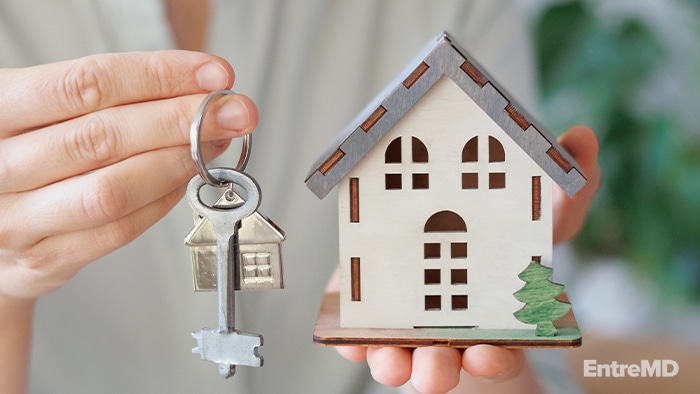Investing your money to build wealth is always the dream. In researching this topic, I laughed when I read there are just “Three Simple Steps to Building Wealth.” Really? Just three? And they’re simple?
 I’m talking about:
I’m talking about:
 After financial services, the industry raised the second-highest amount of global venture funding last year, grabbing attention. With almost 30 billion dollars brought in 2021, which was nearly double the year before, making it an attractive investment opportunity in a field we know.
Market watchers say digital therapeutics, personalized medicine, provider-focused infrastructure, mental health, and chronic conditional management are exciting investment growth sectors.
After financial services, the industry raised the second-highest amount of global venture funding last year, grabbing attention. With almost 30 billion dollars brought in 2021, which was nearly double the year before, making it an attractive investment opportunity in a field we know.
Market watchers say digital therapeutics, personalized medicine, provider-focused infrastructure, mental health, and chronic conditional management are exciting investment growth sectors.
 Three types of real estate investment are:
Three types of real estate investment are:
 Some of the best types of short-term investments:
Some of the best types of short-term investments:
 And don’t try to beat the market with stock market investing. Working with a trustworthy, full-time, and experienced stock market professional will benefit you regarding tax implications, fee structures, and any timing of trading.
Some of the best long-term investments:
And don’t try to beat the market with stock market investing. Working with a trustworthy, full-time, and experienced stock market professional will benefit you regarding tax implications, fee structures, and any timing of trading.
Some of the best long-term investments:
 Other popular cryptocurrencies are:
Other popular cryptocurrencies are:
 This value is based on their relative rarity, and they don’t depreciate very often – in many cases, they will hold their value regardless of their condition. Even if you melt it, burn it or bend it, you’re still left with the same atomic structure — its intrinsic value and rarity.
Art and antiques ideally, though not always, continue appreciating over time. Most people buying art and antiques will represent only a small fraction of a well-rounded investment portfolio.
They are long-term investments and should be considered extra, not essential. As well, it’s important to remember that art and antiques are both non-liquid (meaning it’s difficult to convert into cash right away), and you’ll be paying taxes on any gains.
If you’re interested in investing in the world of art and antiques, the best approach is to consider the aesthetic pleasure first and the financial benefits second. Don’t plan your financial future around any profits you get.
Collectibles are anything that you can sell for more money than it was initially worth. Think classic cars, comics, trading cards, stamps, etc. While they may be rare, even mass-produced items can become collectibles, like fine art or old comic books. Some of these are worth millions of dollars today.
Like art and antiques, consider the aesthetic pleasure first and the financial benefits second. Who knows, the pristine collection of the 1950s and 1960s wing-tipped plastic sunglasses with glass lenses Aunt Judy left in her attic could bring you a welcome windfall!
As doctors, we all work hard and are laser-focused every day to care for our patients’ needs. But, we also need to step back and look at the big picture of building our businesses of impact.
Investing our money well should be part of that picture. If you’d like to hear more about how I help doctors just like you change how they view their medical business, click here to send me a message. I promise to respond to you!
This value is based on their relative rarity, and they don’t depreciate very often – in many cases, they will hold their value regardless of their condition. Even if you melt it, burn it or bend it, you’re still left with the same atomic structure — its intrinsic value and rarity.
Art and antiques ideally, though not always, continue appreciating over time. Most people buying art and antiques will represent only a small fraction of a well-rounded investment portfolio.
They are long-term investments and should be considered extra, not essential. As well, it’s important to remember that art and antiques are both non-liquid (meaning it’s difficult to convert into cash right away), and you’ll be paying taxes on any gains.
If you’re interested in investing in the world of art and antiques, the best approach is to consider the aesthetic pleasure first and the financial benefits second. Don’t plan your financial future around any profits you get.
Collectibles are anything that you can sell for more money than it was initially worth. Think classic cars, comics, trading cards, stamps, etc. While they may be rare, even mass-produced items can become collectibles, like fine art or old comic books. Some of these are worth millions of dollars today.
Like art and antiques, consider the aesthetic pleasure first and the financial benefits second. Who knows, the pristine collection of the 1950s and 1960s wing-tipped plastic sunglasses with glass lenses Aunt Judy left in her attic could bring you a welcome windfall!
As doctors, we all work hard and are laser-focused every day to care for our patients’ needs. But, we also need to step back and look at the big picture of building our businesses of impact.
Investing our money well should be part of that picture. If you’d like to hear more about how I help doctors just like you change how they view their medical business, click here to send me a message. I promise to respond to you!
- Make money
- Save money
- Invest money
- How much money you can set aside for investments
- Your risk tolerance
- When you may need to access your money in the future
- The number of available investment years you have left
1. Invest in Yourself
Without a doubt, the first type of investment you should practice for the rest of your life is to invest in yourself. I’m not talking here about buying a yacht or spending your money on “splurges.” I’m talking about:
I’m talking about:
- Eliminating high-interest debt
- Paying yourself first
- Giving away
“I would never have been able to tithe the first million dollars I ever made if I had not tithed my first salary, which was $1.50 per week.”
2. Invest in a New Business
Investing in health start-ups is currently a hot topic and can be particularly attractive to doctors as we care about human health and understand the problems. Digital health products and services seem to be stabilizing and are predicted to continue being popular even after the brunt of COVID-19 subsides strongly. After financial services, the industry raised the second-highest amount of global venture funding last year, grabbing attention. With almost 30 billion dollars brought in 2021, which was nearly double the year before, making it an attractive investment opportunity in a field we know.
Market watchers say digital therapeutics, personalized medicine, provider-focused infrastructure, mental health, and chronic conditional management are exciting investment growth sectors.
After financial services, the industry raised the second-highest amount of global venture funding last year, grabbing attention. With almost 30 billion dollars brought in 2021, which was nearly double the year before, making it an attractive investment opportunity in a field we know.
Market watchers say digital therapeutics, personalized medicine, provider-focused infrastructure, mental health, and chronic conditional management are exciting investment growth sectors.
3. Invest in Real Estate
According to a 2016 Gallup Poll, real estate was rated the best long-term investment, well ahead of other types of investment for several reasons. Owning real estate is a way to boost your monthly income, gives long-term security, has tax advantages, lets you leverage funds, and is a protection against inflation. While short-term and long-term investments can be volatile, real estate isn’t affected in the same way. Even if other assets decline in value, real estate keeps earning steady returns. Let’s say you buy a property for $200,000 and put $60,000 (30%) down, and a few years later, you sell this property for $300,000. You’ve now made a 166.67% return on your investment. Of course, you’ll have to subtract any repairs and maintenance costs over the time you owned the property, but that’s a healthy return! You could also choose to hold on to your investment property and rent it out. As long as you can rent out the building for more than the mortgage, property tax, and any maintenance and repair bills, your tenant will be paying down your mortgage. Three types of real estate investment are:
Three types of real estate investment are:
- Residential real estate
- Commercial real estate
- Industrial real estate
4. Short-term Investments
Short-term investments help keep your money safe while taking advantage of compounding interest. It’s a way to protect cash that may be needed for the future and is relatively low risk. While your grandparents might have invested in buying savings bonds and earning a nice income, the Federal Reserve set today’s short-term interest rates at 0. Experts say the typical short-term investment is expected to grow for several months to a few years and can be cashed in once they reach maturity. Look for investments that have stability, liquidity, and low transaction costs. Some of the best types of short-term investments:
Some of the best types of short-term investments:
- High-yield savings accounts offer competitive interest rates without charging any fees.
- Money market accounts are considered a “savings account on steroids” and allow you immediate access to your funds.
- Alternative investments operate outside the stock market but don’t come with a 10-year penalty timeline.
- Certificates of deposit (CDs) hold your money for a specific length of time in exchange for a guaranteed return no matter what happens to interest rates.
- A Roth IRA is funded with after-tax income, so you are free to withdraw the contributions you made.
- Online checking accounts tend to offer cash bonuses depending on your deposit.
- Short-term bond funds and ETFs are usually only managed by a professional financial advisor, and while they’re not as stable as money markets, they offer a higher yield potential.
5. Long-term Investments
Long-term investments are typically riskier than other types of investment, but the returns can be higher. You’ll need to hold on to them for a minimum of five years, or better still, decades. Over the long term, you can expect a 9 to 10 percent per year for these types of investments, and if you run a small business, you can earn even higher returns. The key to winning with long-term investments is not to bail when things look bleak. Even the best investments go through depressed periods. So hold on, and rather than selling, consider buying more. And don’t try to beat the market with stock market investing. Working with a trustworthy, full-time, and experienced stock market professional will benefit you regarding tax implications, fee structures, and any timing of trading.
Some of the best long-term investments:
And don’t try to beat the market with stock market investing. Working with a trustworthy, full-time, and experienced stock market professional will benefit you regarding tax implications, fee structures, and any timing of trading.
Some of the best long-term investments:
- Stocks are the primary long-term investments and include equity index funds and exchange-traded funds (ETFs).
- Blue-chip company individual stocks with solid long-term performances are less risky than individual stocks and are less likely to experience big swings.
- Bonds are considered much less risky than stocks because they provide regular income payments. Their owners will receive payment before stockholders if a company folds.
6. Cryptocurrency
At its core, cryptocurrency is:“Decentralized digital money in which transactions are verified and records maintained by a decentralized system using cryptography, rather than by a centralized authority.”What’s the point of cryptocurrencies? They provide “an outlet for personal wealth beyond restriction and confiscation.” The first cryptocurrency, Bitcoin, was launched in 2008 and is still the biggest, most influential, and best-known cryptocurrency. Its market cap (total value of all the coins that have been mined) is over $846 billion.
 Other popular cryptocurrencies are:
Other popular cryptocurrencies are:
- Ethereum has a market cap of over $361 billion
- Tether (USDT) has a market cap of over $79 billion
- Binance Coin (BNB) has a market cap of over $68 billion
- US Dollar Coin (USDC) has a market cap of over $53 billion
“Most importantly, cryptocurrencies allow individuals to take complete control over their assets.” Brian Armstrong, Co-founder & CEO of CoinbaseJust exercise due to caution. As an unregulated financial vehicle with a low barrier to entry, scams are extremely common in the crypto space. Be careful which ones you choose to invest in.
7. Alternate Investments
Apart from all the investment opportunities listed above, there are a few ways to invest in your future that don’t neatly fall into these first six and aren’t tied to the stock market. While one of these is considered intrinsic value, the other three can be considered investments based on their market value.- Precious materials
- Art
- Antiques
- Collectibles
 This value is based on their relative rarity, and they don’t depreciate very often – in many cases, they will hold their value regardless of their condition. Even if you melt it, burn it or bend it, you’re still left with the same atomic structure — its intrinsic value and rarity.
Art and antiques ideally, though not always, continue appreciating over time. Most people buying art and antiques will represent only a small fraction of a well-rounded investment portfolio.
They are long-term investments and should be considered extra, not essential. As well, it’s important to remember that art and antiques are both non-liquid (meaning it’s difficult to convert into cash right away), and you’ll be paying taxes on any gains.
If you’re interested in investing in the world of art and antiques, the best approach is to consider the aesthetic pleasure first and the financial benefits second. Don’t plan your financial future around any profits you get.
Collectibles are anything that you can sell for more money than it was initially worth. Think classic cars, comics, trading cards, stamps, etc. While they may be rare, even mass-produced items can become collectibles, like fine art or old comic books. Some of these are worth millions of dollars today.
Like art and antiques, consider the aesthetic pleasure first and the financial benefits second. Who knows, the pristine collection of the 1950s and 1960s wing-tipped plastic sunglasses with glass lenses Aunt Judy left in her attic could bring you a welcome windfall!
As doctors, we all work hard and are laser-focused every day to care for our patients’ needs. But, we also need to step back and look at the big picture of building our businesses of impact.
Investing our money well should be part of that picture. If you’d like to hear more about how I help doctors just like you change how they view their medical business, click here to send me a message. I promise to respond to you!
This value is based on their relative rarity, and they don’t depreciate very often – in many cases, they will hold their value regardless of their condition. Even if you melt it, burn it or bend it, you’re still left with the same atomic structure — its intrinsic value and rarity.
Art and antiques ideally, though not always, continue appreciating over time. Most people buying art and antiques will represent only a small fraction of a well-rounded investment portfolio.
They are long-term investments and should be considered extra, not essential. As well, it’s important to remember that art and antiques are both non-liquid (meaning it’s difficult to convert into cash right away), and you’ll be paying taxes on any gains.
If you’re interested in investing in the world of art and antiques, the best approach is to consider the aesthetic pleasure first and the financial benefits second. Don’t plan your financial future around any profits you get.
Collectibles are anything that you can sell for more money than it was initially worth. Think classic cars, comics, trading cards, stamps, etc. While they may be rare, even mass-produced items can become collectibles, like fine art or old comic books. Some of these are worth millions of dollars today.
Like art and antiques, consider the aesthetic pleasure first and the financial benefits second. Who knows, the pristine collection of the 1950s and 1960s wing-tipped plastic sunglasses with glass lenses Aunt Judy left in her attic could bring you a welcome windfall!
As doctors, we all work hard and are laser-focused every day to care for our patients’ needs. But, we also need to step back and look at the big picture of building our businesses of impact.
Investing our money well should be part of that picture. If you’d like to hear more about how I help doctors just like you change how they view their medical business, click here to send me a message. I promise to respond to you! 

